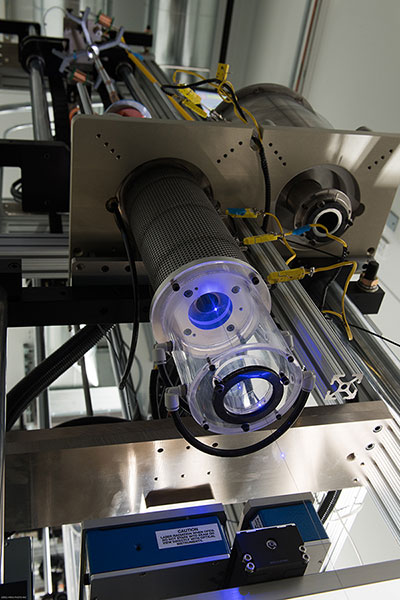
As a non-profit, public-private partnership, Advanced Functional Fabrics of America (AFFOA) bridges the gap between early stage technology and commercialization. Funded by the Department of Defense (DoD) and founded in 2016, AFFOA uses its expertise in fibers and fabrics, as well as membership ecosystems, to advance the domestic development of textile-based products with transformative capabilities.
When asked about his role, AFFOA CEO Sasha Stolyarov defined it as leading an organization that has huge potential to transform what manufacturing looks like in the U.S. “I serve to inspire and break down barriers for communication and for collaboration,” he said. “I lead a very talented team that is highly multidisciplinary in nature and enables us to move our mission forward. I’m also here to learn and understand the needs of the industry so we can adapt, adjust, and be successful in meeting the challenges of tomorrow.”
AFFOA supports a broad range of needs for all stakeholders, from DoD and various government agencies to universities, startups, and manufacturers in different industries.
Threading the Needle
“There is a lot of innovation taking place in advanced functional fibers and fabrics, and people have a vision for what they can do, but there really isn’t an entity set up to connect the dots between innovators, manufacturers, and end-product companies to make things happen in an efficient manner,” Stolyarov explained. “Things do happen organically, of course, but we’re here to make new connections happen and facilitate and accelerate the transition from innovation into real products.”
Stolyarov said it can be a long journey. This is an area referred to as tough tech, meaning it’s not a software problem that someone can code their way into a solution. “We have to manufacture our way into innovation,” Stolyarov explained, adding this can challenging because the manufacturing of advanced functional fabrics requires collaboration by disparate entities and competencies that are not used to working together.

“Our membership is the backbone of the institute. No single company has all the pieces needed to manufacture future advanced highly functional fabric products at scale,” he said. “When we’re tasked with a challenge problem by one of our sponsors, it requires us to tap into the capabilities of our membership network from a wide range of established companies, newly founded start-ups with promising technologies, and universities that often have leading-edge technologies ready for transition.”
In 2022, more than 50 of AFFOA’s members were involved in projects with the Institute, or about one-third of the membership network.
Internal Tech Capabilities
At the 12,000-sq-ft facility that serves as its headquarters in Cambridge, Mass., AFFOA has end-to-end advanced fabric prototyping capabilities that include design and modeling of integrated textile systems, fiber and yarn device processing, textile formation including weaving, knitting, and embroidery as well as e-textile systems integration. AFFOA also has a host of testing capabilities for characterizing fibers and fabrics including electronic, optical, and mechanical testing to ensure the reliability and manufacturability of prototypes.
“We have our own HQ technology platform which is very unique,” Stolyarov said. “It’s an advanced fiber technology that enables the packaging of microelectronics within textile fibers. We are working toward transitioning this technology into the market with a broad range of applications guiding the way, including defense, industrial condition monitoring, and fabric-integrated health monitoring systems.”
Because AFFOA has a diverse team in terms of expertise, it can directly fill various needs for industry and serve as an extension of an engineering team that is struggling to find an R&D partner. “There are not that many companies where you can come to them and say, ‘I have an idea for an advanced functional fabric product, can you help me design and make a prototype?’”

Most of the projects AFFOA funds requires a manufacturer to team with a university partner or a startup that has the product idea. “Part of our criteria for projects is you have to work with a manufacturer,” Stolyarov explained. “If you want your innovation to be scalable, you have to produce it on the manufacturing floor.”
A good example of this is Z-Polymers, a Lowell, Mass.-based startup working on innovative fiber applications. CEO Mike Zimmerman was looking to create a few prototypes but had a hard time finding a place with early stage prototyping capabilities. And with a lot of the textile industry leaving the U.S., there was limited domestic R&D capability in advanced textiles and fabrics.
“We’re developing very thin fibers that are six times stronger than steel and much lighter,” Zimmerman said. “The state-of-the-art fibers are made from a polymer material to be very fine and make very thin fabrics.” Zimmerman explained that the first application of the fine woven textile structures is to help enable fuel cells as part of the hydrogen economy. “What AFFOA is trying to do is help small companies like mine scale up and develop state-of-the-art technology in the U.S.,” Zimmerman explained. “It’s a win-win situation. AFFOA is helping us, and we fit within their mission,” he added.

Pharma Plus Fabrics
An early win for the institute, which speaks to the power of the ecosystem, is the story of Nufabrx, the Conover, N.C.-based developer of HealthWear, a patented technology that embeds medications directly into clothing.
CEO Jordan Schindler started Nufabrx with a mission to simplify health and wellness. “Instead of taking a pill, or using a cream or a patch, what if you could just get dressed in the morning?” Schindler explained. “Our core technology enables controlled delivery of vitamins, supplements, and medications through clothing, effective through 15-plus wash cycles.” Imagine a line of topical analgesics infused through a back brace or melatonin in a pillowcase to help you sleep at night. Schindler said Nufabrx is designed to solve the problem of patient compliance. “It’s hard to change consumer behavior, but people get dressed every day,” he added.
In 2017, Schindler came to the institute with a patent for medication-infused fabrics that deliver controlled delivery of active ingredients including vitamins, supplements, and medication through clothing. He needed a manufacturing partner and was getting wooed by venture capitalists that encouraged him to go overseas. AFFOA introduced Schindler to Manufacturing Solution Center (MSC) in Conover, N.C.
“We really wouldn’t exist without the support of the manufacturing ecosystem, MSC, and AFFOA. You need talent, manufacturing resources, and capital, and AFFOA does a good job to bring all three of those things together.”
Schindler received early funding through AFFOA to commercialize the technology, which was the springboard he needed to ramp up production, keep it in the U.S., and get products into the marketplace.
How’s it going? In 2021, Nufabrx ranked among the top 10 in the 2021 Deloitte Technology Fast 500 list of the fastest-growing companies in North America, and second in the pharmaceutical sector. As a pioneer in health-focused wearable products, which sit at the intersection of traditional textile garments and pharmaceutical products, Nufabrx has its own line of pain relief-infused garments available nationwide at retailers including Target, Walgreen’s, CVS, Amazon, and Walmart.

Pivoting with a Purpose
“When we started the institute, I never thought we’d be focused on making N95 respirators,” Stolyarov said. “In March 2020, we pivoted half our team to work on the problem when we realized there was a shortage of material and end product, and the product coming into this country was of questionable quality.”
So AFFOA set out to find those who knew the materials and connected them with manufacturers that previously never worked together to produce new materials. Many manufacturers transitioned to produce millions of units of personal protective equipment (PPE). Testing was a major issue to ensure the quality of the materials and their filtration efficiency. The government uses National Institute for Occupational Safety and Health (NIOSH) labs to certify N95 masks and other devices.
“There was a backlog for months to get materials tested,” Stolyarov said. “We knew we had universities and partners in our ecosystem that studied particle filtration for different uses, and we asked them to set up a capability to test PPE materials. We did that with MIT, MIT Lincoln Laboratory, and UMASS Lowell, three of our close partners. Within a matter of weeks, these labs that previously never served the purpose of testing anything from the outside world, became the testing center for materials developed all over the country.”
Making a Meaningful Impact
AFFOA is firmly focused on bringing ideas—and products—to life that make a difference in people’s lives. “There’s a startup in our network developing a glove for rehabilitation for stroke survivors,” Stolyarov said, referring to Imago Rehab, a Massachusetts-based medical equipment manufacturer that enables recovery outcomes for stroke survivors through a combination of home-use wearable robotics and digital health. “It’s an amazing concept and would make a world of difference if we can produce it at scale,” Stolyarov said, adding that AFFOA engineers are advising the company on design-for-manufacturability and improving integration of the complex glove system that includes textiles, electronics, and actuating domains.
Another project that holds significant potential is an emerging HQ technology in the form of a fiber system that can be deployed in the ocean to measure pressure, temperature, and salinity over large areas. “This is significant for the Navy and climate science,” Stolyarov explained. “We are working toward a demonstration where we will develop fibers hundreds of meters long that can literally take a picture of ocean conditions. This promises to be a game-changing capability.”
These ambitious projects speak to Stolyarov’s vision and the work of the entire AFFOA team. In collaboration with key stakeholders, they are prepared to move mountains and support the needs of DoD, startups, universities, and the industry, all while keeping manufacturing stateside.

